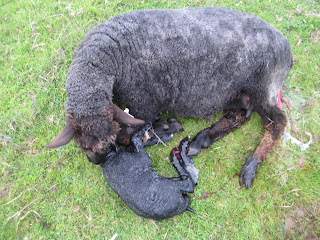


This has been a baby year, with two sets of triplets, lots and lots of twins, and just a few singles. Lots of colored Shetlands, black, deep brown, and mottled black and white. Yolo, the ram I used last year threw mainly white sheep, so I am delighted that Moca, this year's Shetland ram, has endowed his babies with so much color.

In all of this, the old moms and new moms have to get used to being a family. I am sad to report that Cookie, one of our favorites and a star with her fleece in the CSA offering, well, Cookie has been the worst mother of the lot!
Cookie can't find her babies. They might be right underneath her nose, sleeping peacefully, but she has a tizzy fit, and bellows for them louder than any fog horn. If I hear a momma calling ceaselessly for her babies, I usually come running to make sure everything is okay. After dropping my trowel, my towel, my pen, or my shovel to dash to the pasture like a fireman for a fire and finding it another false Cookie alarm, I have retuned my emergency alarm to discount Cookie calls. You can see below she has found one of her lambs, but the other, a male whom I call Harlequin, has disappeared.
Here he is, the black and white guy in the center. He likes hanging out with his buddies, and who cares if Mom is worried.
I can just hear Harlequin thinking it is so fun to play with other little lambs, and not mind the calls of his mother!

Here he is sampling grass, regardless of the strident calls of his mother.
Finally, Cookie got Harlequin back to her and promptly urged him to eat, eat, eat, like any good mother.
Here they are, with Harlequin looking resigned to be plodding along after his mother.

I have somewhat lost track, but I think we are up to about 35 babies, with about eight moms to go. Whenever you have successes in the lamb barn, there are also tragedies. Unfortunately, I think I have the problem with the Shetland sheep I had some years ago, a mineral deficiency that causes lambs flat with weakness at birth. I lost one twin last week, but I did bring the other around, but now I have another little guy, so weak he can't stand up. His mother is a first timer but very gentle allowing me to milk her so I can feed the guy his own mother's milk. It isn't doing much good, but he is just 36 hours old. He seemed to be doing better earlier in the day, but now he is so weak that he isn't sucking at the bottle. All I can do is to try and keep him warm and fed, even if just with a syringe and hope that he makes it longer to gain a bit more strength. The Davis Vet School is doing an autopsy on the first baby I lost, and I hope to learn what is causing this problem.
This wonderful late rain, good for the ground water total but terrible weather for lamb babies, has me worried, for the wild cold winds just off the Pacific tend to breed pneumonia in the lambs. Even though I have vaccinated, I am looking forward to the weather change to a kindlier nature. Last night, at 9 pm, I found a number of moms making their babies rough it out in the swirls of rain and gusts of wind. By the time I got everyone locked into the barn, I was sopping wet and sorely out of temper. Inside the barn, it looked like an a shutdown airport with everyone sleeping in the aisles. It was crowded!
What to do? I will have to think clearly about how many sheep this farm can hold with careful consideration of my stewardship of the land. If the weather clears, and the sheep are back out in the night pastures, it won't be so bad, so surely this is a decision for another day.



















































